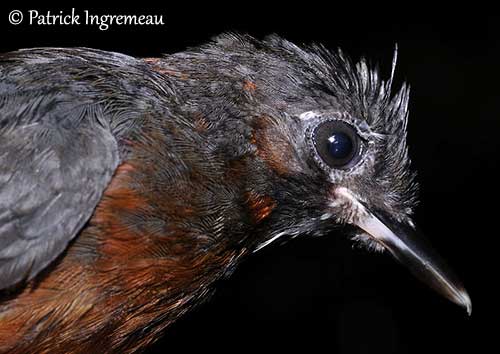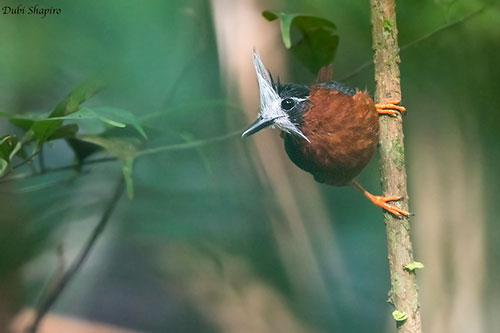
The female often lays two pinkish-white eggs with darker flecks. Both parents probably share the incubation estimated at 15 days. The chicks leave the nest about 12 days after hatching, but they are fed for one or two months after fledging. Each adult rears one fledgling.
In some parts of the range, these birds breed almost all year round, and the female may leave her mate which is caring for the young, in order to start up a new cycle with another male.
PROTECTION / THREATS / STATUS:
The White-plumed Antbird is usually fairly common throughout the range, but it is suspected to lose suitable habitat caused by Amazonian deforestation, involving fragmentation and modification of its preferred habitats.
The size of the population is unknown, but the species is not considered globally threatened.
The White-plumed Antbird is currently evaluated as Least Concern.
Fr: Fourmilier manikup
Ang: White-plumed Antbird
All: Weißgesicht-Ameisenvogel
Esp: Hormiguero Cuerniblanco
Ita: Formichiere piumebianche
Nd: Witpluimmiervogel
Sd: vitplymad myrfågel
Photographers:
Patrick Ingremeau
TAMANDUA
William Price
PBase-tereksandpiper & Flickr William Price
Dubi Shapiro
Dubi Shapiro Photo Galleries
Text by Nicole Bouglouan
Sources:
HANDBOOK OF THE BIRDS OF THE WORLD Vol 8 By Josep del Hoyo-Andrew Elliott-David Christie - Lynx Edicions - ISBN: 8487334504
BIRDS OF SOUTH AMERICA – Passerines - by Robert S. Ridgely and Guy Tudor – HELM Field Guides – ISBN: 9781408113424
The Birds of South America: Vol. II, The Suboscine Passerines De Robert S. Ridgely, Guy Tudor, William L. Brown, World Wildlife Fund – Editeur: University of Texas Press, 1989 – ISBN: 0292770634, 9780292770638 – 940 pages
A GUIDE TO THE BIRDS OF COLOMBIA by Steven L. Hilty and William L. Brown
Princeton University Press – ISBN 069108372X
PORTRAITS D’OISEAUX GUYANAIS - Groupe d'étude et de protection des oiseaux en Guyane (GEPOG) - Ibis rouge éditions - ISBN: 2844501842
Arthur Grosset's Birds (Arthur Grosset)
Wikipedia, the free encyclopaedia

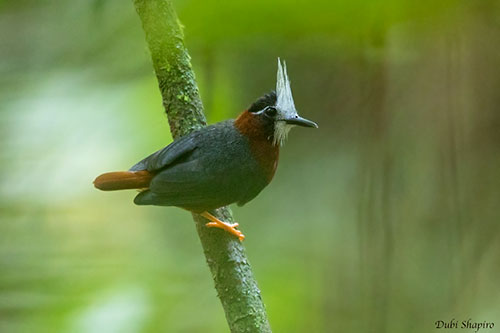
White-plumed Antbird
Pithys albifrons
Passeriformes Order – Thamnophilidae Family
INTRODUCTION:
The White-plumed Antbird is a small insectivorous species usually found in rainforest, and especially in the understorey.
The antbirds of the family Thamnophilidae are known to use ants, mainly army ants, to locate food items. The birds rely on them to flush out their favourite prey from the leaf litter, often insects, arthropods, and occasionally lizards.
The White-plumed Antbird occurs in Brazil, Colombia, Venezuela, Ecuador, Peru and also the Guianas. They frequent forests with high canopies and dense, varied undergrowth. They usually avoid open habitats.
The species nests in a cup-shaped structure placed in mat of dead leaves, a few tens of centimetres above the ground. Both parents share the nesting duties.
The White-plumed Antbird is described as fairly common, although it is threatened by habitat loss caused by deforestation involving fragmentation of the habitat.
But currently, the species is not considered globally threatened.
DESCRIPTION OF THE BIRD:
Biometrics:
Length: 12-13 cm
Weight: 18-23 g
The White-plumed Antbird adult has dark blue-grey mantle and wings, whereas nuchal collar, rump, tail and underparts are chestnut. Flanks are tinged grey. Head and throat are black.
On the black head, crown and ear-coverts down to throat sides are black. We can see a narrow, contrasting white postocular streak.
But the bird is unmistakable with unique ornate facial plumes. There are conspicuous, long, white plumes on each side of the forehead. They are very often held straight up in a bifurcated point.
Another tuft of white plumes is visible on the chin. They are shorter and form a “beard”.
The fairly large, heavy bill is black. The eyes are dark brown. Legs and feet are bright orange-yellow.
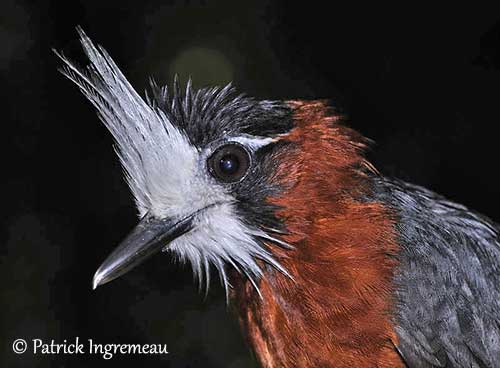
The birds of genus Pithys have large, strong feet and legs, but also modifications of both toes and soles of the feet to make gripping easier. The birds are able to cling laterally to vertical stems and saplings while following the swarms of ants.
The female resembles male.
The juvenile is duller than adults. White tufts, white postocular streak and chestnut nuchal collar are absent. The upperparts are browner and the underparts are greyer.
SUBSPECIES AND RANGE:
The White-plumed Antbird has two subspecies.
P.a. albifrons (described above) is found in S Venezuela to the Guianas and Brazil, N of R Amazon.
P.a. peruvianus occurs in E Colombia to W Venezuela, NW Amazonian Brazil, E Ecuador and N and C Peru.
This race lacks the white postocular streak.
The populations from NW Amazonia are sometimes separated as race “brevibarba” but it seems to intergrade with “peruvianus” over a wide area.
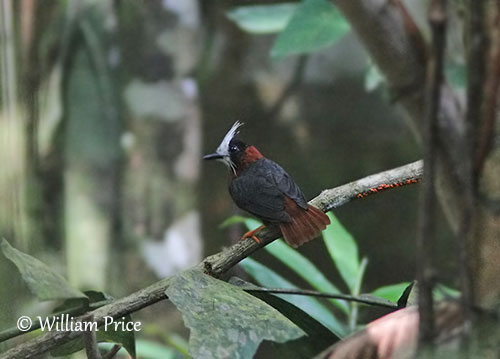
HABITAT:
The White-plumed Antbird often frequents rainforest’s undergrowth, and less often adjacent second growth and forest borders. It is mainly found up to 1,100 metres of elevation, sometimes up to 1,350 metres, depending on the range.
This species avoids open habitats and does not cross rivers.
CALLS AND SONGS: SOUNDS BY XENO-CANTO
The White-plumed Antbird is known to have a repertoire of eleven sounds, and among them three calls are fairly unusual.
The song infrequently heard is given from a perch 3-6 metres up. The song is a series of emphatic whistled notes ascending in pitch and increasing in intensity. It is described as “tueee-tueee-tueee-tueee-tueee…tueee!-tueee!-tueee!”
We can hear a nasal “churr” or “chirr” call, especially when the bird becomes nervous. It also gives sharp “chip” notes, usually repeated 2-3 times very rapidly.
The White-plumed Antbird also utters repeated “churr” notes while following ant swarms through the undergrowth.
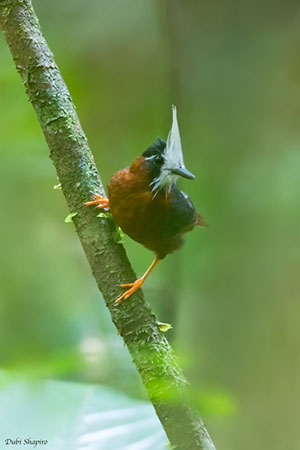
BEHAVIOUR IN THE WILD:
The White-plumed Antbird feeds primarily on insects and arthropods, and it may occasionally take lizards.
This species is closely related to active army ants that flush out prey items from the leaf litter. Usually, up to 10-12 individuals or more may gather over a single swarm. The bird is rarely seen away from ants and seems completely dependent on them.
However, the swarms are not easy to find and hard to see. The antbird clings to small vertical saplings and bounces from one to another low over the swarm. While hunting, it darts to the ground or sallies to vegetation, and may sometimes hop on the ground to catch prey.
The White-plumed Antbird may remain motionless for long periods, in order to avoid attacks by larger antbird species or predators. If alarmed, it darts back and forth while uttering chipping notes. It spreads the tail and moves quickly to catch some prey before to flee.
This species is solitary outside of breeding season.
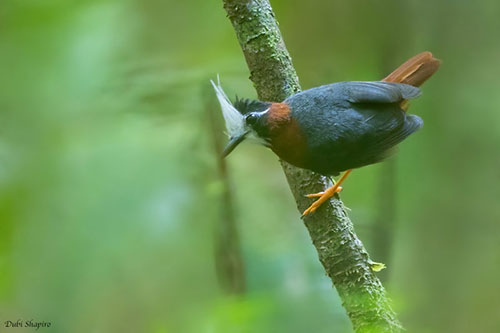
At the beginning of the breeding season, the male performs courtship feeding and both mates also perform mutual grooming. The male shows several possible nest-sites to the female.
The territory is defended all year round. The white head feathers play an important role both in courtship and defence. Both adults share the nesting duties such as nest-building and chick-rearing. They are generally monogamous.
The White-plumed Antbird is probably resident throughout the range.
The flight is agile when the bird is foraging, thanks to the short, elliptical wings, well-adapted for hunting and moving through the dense vegetation.
REPRODUCTION OF THIS SPECIES:
The breeding season takes place between July and April in Venezuela, from December to August in Guyana, between December and May in French Guyana, and in all months in Brazil.
The White-plumed Antbird builds a bottom-supported cup-shaped nest atop vegetation such as small palms, sedges or tuberous plants, always live plants. But there is often a mat of dead leaves above, to hide the nest from predators.
The nest is made with dark fibrous rootlets as inner lining, and dead leaves as outer layer. It is usually built a few tens of centimetres above the ground.
